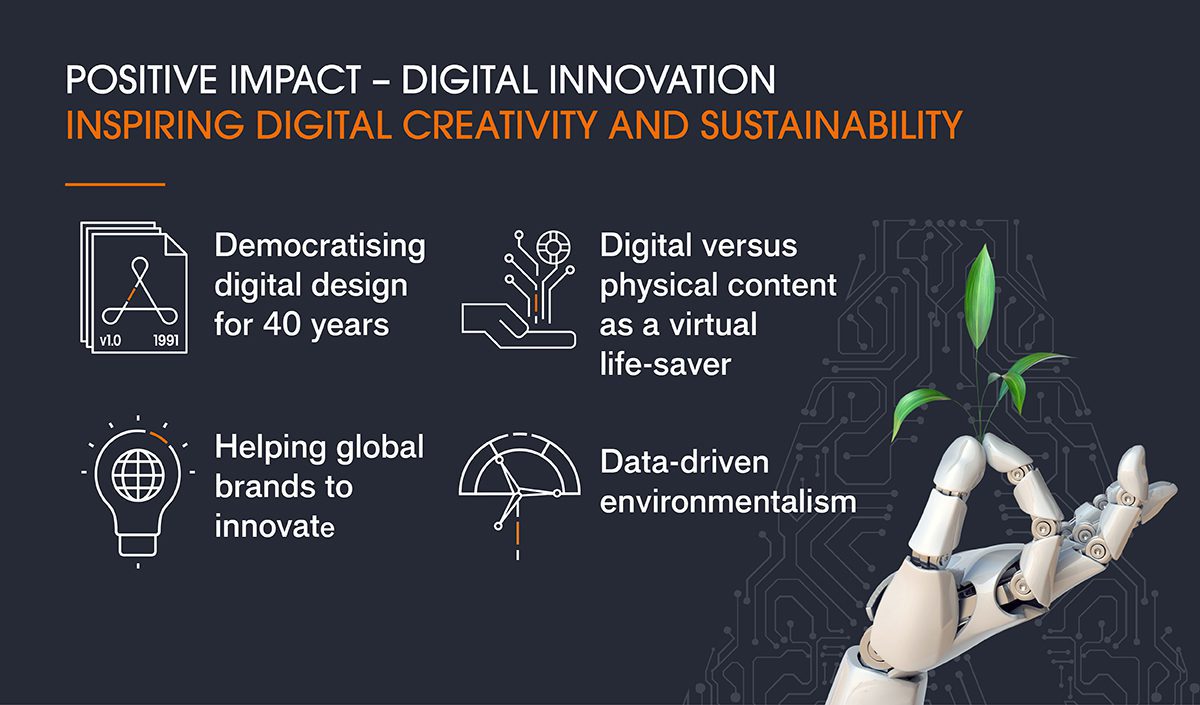Adobe: inspiring digital creativity and sustainability
Hamish Chamberlayne, Head of Global Sustainable Equities, discusses why he considers Adobe a good example of a company that has a positive impact on both society and the environment.

5 minute read
Key takeaways:
- Adobe has been the market leader in digital content creation since 1991, when it launched the globally used PDF.
- Since then, it has reinforced its position by offering a suite of software applications for small and large businesses alike, as well as making day-to-day life easier for personal users.
- Aside from helping customers eliminate waste by transitioning to digital content, Adobe takes its own responsibilities seriously, committing to 100% renewable energy usage by 2035.
If you use a computer for work, leisure or just for handling your personal affairs, then chances are you’ve heard of Adobe. Even if you haven’t, you certainly might have come across Adobe’s products directly or indirectly. Adobe is a US-based technology company that develops and sells software and services for content creation, as well as revolutionising the way digital advertising and marketing is measured.
The company was named after Adobe Creek, a river in Los Altos, California, which ran behind the home of one of its founders, John Warnock. It was Warnock who inspired the launch of the portable document format (PDF) in 1991.1 His vision was to create software that allowed users to share viewable, downloadable and printable electronic documents to any computer at any time. Arguably, the PDF has since become the industry standard for safely sharing digital documents, and has played a key role in the ‘paper-to-digital’ revolution.

Since those early days, companies and creatives have grown accustomed to relying on a host of different Adobe software products to help with everything from graphic design (InDesign), photography (Photoshop), video (Premier Pro), design (Illustrator), website and mobile user experience (XD) and social media. Adobe’s products help to design the magazines we read, the websites we visit, the adverts we watch, and much, much more. Its inventions are helping to drive the creation of ideas and exchange of information, presenting new ways of solving social and environmental problems.
Democratising digital design
For 40 years, Adobe’s software has helped to empower creative and artistic expression. But in corporate terms, its suite of software has proven a game-changer for small and medium-sized businesses. Its products provide the necessary tools for smaller players to compete with much larger competitors, enabling them to create professional-quality content quickly, and help to get that content in front of the right audience – without the need to spend heavily on a creative team or agency to do the work.
For example, photoshoots can be costly and time consuming due to the need for expensive specialist equipment and desire for exotic locations. Adobe’s suite of design and digital prototyping tools have changed the way photoshoots are managed, helping customers to create realistic 3D scenes that can replace traditional photoshoot locations. In turn, businesses are able to produce great results at low cost and with a smaller environmental impact.
Helping global brands to innovate Digital versus physical content
Adobe might not have captured headlines during the pandemic, but it was a quiet success story. For many businesses, the ability to operate digitally was a virtual life-saver. When lockdowns were enforced and employees had to work from home, it became impossible for many paper-based business transactions to go ahead. Paying in cheques, signing contracts and leases and other forms of administration suddenly became a burden. But the implementation of Adobe software that authorised electronic signatures – such as PDFs and its cloud-based e-signature business service Adobe Sign – became essential for many companies to continue a successful operation. Adobe is positioned to benefit from the changes in business practices and people’s behaviour that the pandemic has accelerated.
Environmentally-friendly practices
Adobe’s software innovation has helped advance the digitalisation of content, eradicating printing and distribution processes that consume valuable physical resources. However, even digital services carry an environmental cost. According to some estimates, the carbon footprint of digital technology (including the internet and the systems that support it) accounts for 3.7% of global greenhouse gas emissions.4 Adobe recognises this, using renewable energy to power its data centres, and is always looking for new ways to reduce its energy consumption.
Societal responsibility drives action
Adobe also has a strong focus on corporate social responsibly, which is fundamental to the way its employees, customers and communities in which it operates interact. In today’s digital age, data stewardship and the way that we conduct our digital lives is of fundamental importance. Breaches of data privacy are not only devastating and cumbersome to rectify, but also come with legal implications such as the General Data Protection Regulation (GDPR) in the European Union. Adobe helps to keep its customers on the right side of the law by factoring strong governance principles into the tools it creates. By providing a robust framework and process for its customers to follow, Adobe ensures that consumer data is handled correctly and with integrity.
For over 30 years Adobe has continued to innovate, extending its reach far beyond its most famous product, the humble PDF. We believe its inventions drive the creation of ideas and exchange of information, presenting new ways of solving social and environmental problems and the transition to a subscription-based model for its services has seen it grow from strength to strength. Today, Adobe has created a range of essential products and services that have helped it to expand its customer base and build a devoted following, while continuing to use its reputation to promote sustainability and positive change.
1 Adobe fast facts, 2021
2 Adobe blog, customer success stories, The Home Depot case study, 2019
3 Adobe blog, customer success stories, Natwest case study, 2020
4 Lean ICT: Towards digital sobriety, March 2019, data as at 2018
5 Adobe, Corporate Responsibility, energy conversation
6 Adobe CDP Climate Change questionnaire, 2021
7 Science based targets, Over 150 global corporations urge world leaders for net-zero recovery from COVID-19, 2020
8 Adobe blog, Coming Together + Supporting Our Communities in the Face of COVID-19, 2020
9 Adobe blog, Adobe named a World’s Best Workplace for fifth year in a row, 2020
10 Adobe, Adobe Employee Community Fund, 2019
These are the views of the author at the time of publication and may differ from the views of other individuals/teams at Janus Henderson Investors. References made to individual securities do not constitute a recommendation to buy, sell or hold any security, investment strategy or market sector, and should not be assumed to be profitable. Janus Henderson Investors, its affiliated advisor, or its employees, may have a position in the securities mentioned.
Past performance does not predict future returns. The value of an investment and the income from it can fall as well as rise and you may not get back the amount originally invested.
The information in this article does not qualify as an investment recommendation.
Marketing Communication.
Important information
Please read the following important information regarding funds related to this article.
- Shares/Units can lose value rapidly, and typically involve higher risks than bonds or money market instruments. The value of your investment may fall as a result.
- Shares of small and mid-size companies can be more volatile than shares of larger companies, and at times it may be difficult to value or to sell shares at desired times and prices, increasing the risk of losses.
- If a Fund has a high exposure to a particular country or geographical region it carries a higher level of risk than a Fund which is more broadly diversified.
- This Fund may have a particularly concentrated portfolio relative to its investment universe or other funds in its sector. An adverse event impacting even a small number of holdings could create significant volatility or losses for the Fund.
- The Fund follows a sustainable investment approach, which may cause it to be overweight and/or underweight in certain sectors and thus perform differently than funds that have a similar objective but which do not integrate sustainable investment criteria when selecting securities.
- The Fund may use derivatives with the aim of reducing risk or managing the portfolio more efficiently. However this introduces other risks, in particular, that a derivative counterparty may not meet its contractual obligations.
- If the Fund holds assets in currencies other than the base currency of the Fund, or you invest in a share/unit class of a different currency to the Fund (unless hedged, i.e. mitigated by taking an offsetting position in a related security), the value of your investment may be impacted by changes in exchange rates.
- When the Fund, or a share/unit class, seeks to mitigate exchange rate movements of a currency relative to the base currency (hedge), the hedging strategy itself may positively or negatively impact the value of the Fund due to differences in short-term interest rates between the currencies.
- Securities within the Fund could become hard to value or to sell at a desired time and price, especially in extreme market conditions when asset prices may be falling, increasing the risk of investment losses.
- The Fund could lose money if a counterparty with which the Fund trades becomes unwilling or unable to meet its obligations, or as a result of failure or delay in operational processes or the failure of a third party provider.
Specific risks
- Shares/Units can lose value rapidly, and typically involve higher risks than bonds or money market instruments. The value of your investment may fall as a result.
- Shares of small and mid-size companies can be more volatile than shares of larger companies, and at times it may be difficult to value or to sell shares at desired times and prices, increasing the risk of losses.
- The Fund follows a sustainable investment approach, which may cause it to be overweight and/or underweight in certain sectors and thus perform differently than funds that have a similar objective but which do not integrate sustainable investment criteria when selecting securities.
- The Fund may use derivatives with the aim of reducing risk or managing the portfolio more efficiently. However this introduces other risks, in particular, that a derivative counterparty may not meet its contractual obligations.
- If the Fund holds assets in currencies other than the base currency of the Fund, or you invest in a share/unit class of a different currency to the Fund (unless hedged, i.e. mitigated by taking an offsetting position in a related security), the value of your investment may be impacted by changes in exchange rates.
- When the Fund, or a share/unit class, seeks to mitigate exchange rate movements of a currency relative to the base currency (hedge), the hedging strategy itself may positively or negatively impact the value of the Fund due to differences in short-term interest rates between the currencies.
- Securities within the Fund could become hard to value or to sell at a desired time and price, especially in extreme market conditions when asset prices may be falling, increasing the risk of investment losses.
- The Fund could lose money if a counterparty with which the Fund trades becomes unwilling or unable to meet its obligations, or as a result of failure or delay in operational processes or the failure of a third party provider.
- In respect of the equities portfolio within the Fund, this follows a value investment style that creates a bias towards certain types of companies. This may result in the Fund significantly underperforming or outperforming the wider market.
